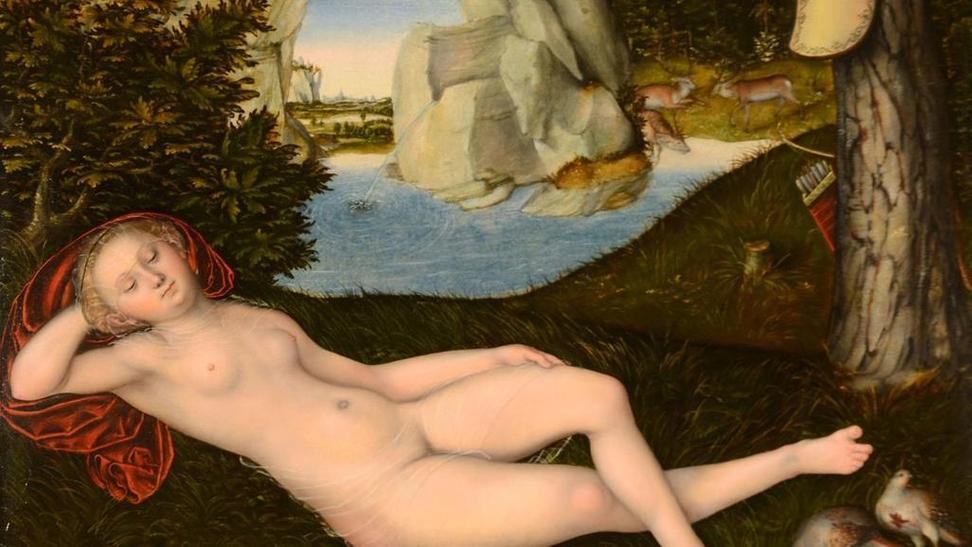The San Diego Museum of Art announced last month the acquisition of two outstanding paintings, Nymph of the Spring (ca. 1540) by Lucas Cranach the Younger and Portrait of John Alfred Parsons Millet (1892) by John Singer Sargent.
Both works fill important gaps in the Museum’s holdings, with the Sargent strengthening the already expansive collection of portraits, and the Cranach being the most important Northern Renaissance painting in the collection.
Nymph of the Spring is currently on display in Genre and Myth, and Portrait of John Alfred Parsons Millet is on view in the American Art galleries.

“Nymph of the Spring” (ca. 1537-1540) by Lucas Cranach the Younger(San Diego Museum of Art)
Nymph of the Spring by Lucas Cranach the Younger is an exceptionally well-preserved painting of a nude lying in a landscape, softly gazing at the viewer. The son of Lucas Cranach the Elder (1472–1553), a well-known German Renaissance artist, Lucas the Younger (1515–1586) followed in his father’s footsteps and the two became the greatest artistic proponents of the Reformation. Together, the family ran one of the most influential art workshops of that time, which Lucas the Younger took charge of about a decade before his father died. Nymph of the Spring was painted during this time, when father and son often worked together, and it appears likely that the elder Cranach contributed some of the more delicate features of the female figure.
Extensive technical analysis of the paint layer and underlying support were carried out at the Balboa Art Conservation Center under the supervision of Dr. Michael Brown, Associate Curator of European Art at The San Diego Museum of Art. Evidence from these examinations supports the authenticity of the work and clearly indicates the excellence of its condition. This painting’s remarkable state of preservation has allowed its immediate display for the enjoyment of visitors to the Museum. Nymph of the Spring was purchased from London-based owners with funds provided by Toni Bloomberg; Gene and Taffin Ray; an anonymous donor; Kevin Rowe & Irene Vlitos Rowe, and the Museum’s Acquisition Fund.
“During the time of the Reformation, Cranach’s mythological scenes like this one were especially popular with his sophisticated patrons, when Humanism and the Italian Renaissance were beginning to reach Northern Europe through artists like Cranach,” said Roxana Velásquez, Maruja Baldwin Executive Director of The San Diego Museum of Art. “Very seldom does a work of such exceptional quality become available, which makes this a very rare opportunity for the Museum to welcome this renowned artist into our permanent collection. We hope this masterpiece, which is now the Museum’s most important Northern Renaissance work, will resonate with and inspire viewers for many years to come.”

Portrait of John Alfred Parsons Millet (ca. 1892) by John Singer Sargent
San Diego Museum of Art
One of The San Diego Museum of Art’s great strengths is an outstanding collection of portraits. To these masterpieces, the Museum has added John Singer Sargent’s (1856-1925) Portrait of John Alfred Parsons Millet, which now hangs alongside portraits by Thomas Eakins and Robert Henri in the American Art galleries. This very personal portrait – the sitter was named after Sargent – captures the young child, caught in a playful, relaxed pose. It is exemplary of Sargent’s skill and flair, and is the first painting by Sargent, the most fashionable portrait painter of his day, to enter the Museum’s collection.
Portraits like this made Sargent one of the first artists to represent children with their own personal qualities rather than more formally as small-scale adults. In his day Sargent was known primarily for his beautiful landscapes and stunning portraits. The artist’s unparalleled mastery of color contrasts and impressionist brushwork made him the most sought-after portraitist of his generation.